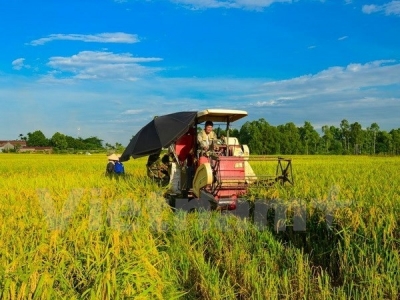Vietnam to reform rice production, improve exports

Vietnam will reform rice production to gain sustainable development in the production and export of rice (Photo: VNA)
Hanoi (VNA) - Vietnam will reform rice production to gain sustainable development in the production and export of rice, according to Vietnam’s Rice Market Development Strategy from 2017 to 2020.
According to the strategy for developing the country’s rice export market in the 2017–20 period with a vision to 2030, one of the goals is to gradually reduce the rice export volume but increase the value of exported rice.
Specifically, the annual rice export volume is expected to reach about 4.5-5 million tonnes in 2020, earning an average of about 2.2-2.3 billion USD per year.
From 2021 to 2030, the nation’s annual rice export volume is expected to reach about 4 million tonnes, earning 2.3 to 2.5 billion USD per year. At the same time, it would restructure rice export products.
Exports of fragrant rice, specialty rice and Japonica rice will account for the largest proportion of the total volume of exported rice at 40 percent, followed by glutinous rice and white rice exports at 25 percent each.
Meanwhile, the proportion of high quality, high-value, organic, highly-nutritious rice and products made from rice will be about 10 percent.
Tran Cong Thang, deputy director of the Institute of Policy and Strategy for Agriculture and Rural Development under the Ministry of Agriculture and Rural Development, said that at present Vietnam does not have a national plan for the development of export rice but provinces have developed areas of producing high-quality rice products while applying high technology for production. In addition, the nation has had geographical indicators for rice products such as Hai Hau rice and Dien Bien rice.
Meanwhile, many local brands have been protected including Kinh Mon glutinous rice in Hai Duong province, Dong Trieu glutinous rice in Quang Ninh province and aromatic rice of Soc Trang province. Many enterprises have developed brands for their business and for their rice products.
Meeting the market demand, in recent years, the area of growing high-quality rice is increasing. Rice exporters are also more active in seeking ways to penetrate high-quality rice markets as well as linking with each other to build the rice production chain. Especially, in the Mekong Delta, there are 10 to 12 brands of rice produced by private enterprises such as Ngoc Troi and Ngoc Dong.
However, Thang said, besides development of high-quality rice, Vietnam still needs to develop rice products in traditional rice markets and expand the export market to Africa.
In addition, Vietnam and many other countries producing rice are experiencing various problems such as salinity intrusion and climate change, so rice production to adapt to climate change is a big challenge, he said.
The MARD has worked with the International Rice Research Institute (IRRI) to develop key rice varieties for each region according to the market demand.
Deputy Minister of Agriculture and Rural Development Le Quoc Doanh said that to implement the restructuring of the rice production industry in Vietnam, the agricultural sector has to improve rice varieties, production technique and infrastructure; set up appropriate mechanisation in production, preservation and processing; and promote production chain. The sector will identify suitable rice varieties for each export market.
He said that initially, the sector would focus on researching high-quality rice varieties and rice production technical package to reduce production cost, improve rice quality, protecting the environment and ensure sustainable agricultural reforms.
To implement Vietnam’s Rice Market Development Strategy for the period 2017 to 2020, the MARD will review and identify rice growing areas with an advantage to adjust production plans and convert areas with inefficient rice production to other purposes. It will plan a schedule on adjusting production scale and output to meet domestic and international demand and the competitive ability of Vietnamese rice.
It will also plan and organise production based on regions of material and regions specialising in the production of rice, demand of specific export markets, and orders of enterprises.
The ministry said that in the first seven months of the year, Vietnam exported 3.3 million tonnes of rice, earning 1.5 billion USD, up 15.7 percent in volume and 13.7 percent in value compared to the January-July period of 2016. China was still the largest export market for Vietnamese rice, followed by the Philippines.
Related news
 Vietnamese, Lao provinces implement hi-tech agriculture project
Vietnamese, Lao provinces implement hi-tech agriculture project Vietnam’s north-central province of Thanh Hoa and Laos’ eastern province of Houaphanh are implementing a project using modern science and technology
 Vietnam, Australia clinch fruit trade deal
Vietnam, Australia clinch fruit trade deal Vietnam and Australia have reached an agreement in which Vietnamese firms can export dragon fruit to Down Under while Australian exporters can ship cherries
 Pepper exports: turnover increased, value decreased
Pepper exports: turnover increased, value decreased Vietnam exported 147,282 tons of pepper of all kinds, valued at US$ 809.2 million, up 21% in turnover but down 18% in value compared to the same period of 2016.